This was published 4 years ago
Forget castles and cobblestones: Visit Europe's hottest new postcodes instead
By Brian Johnston
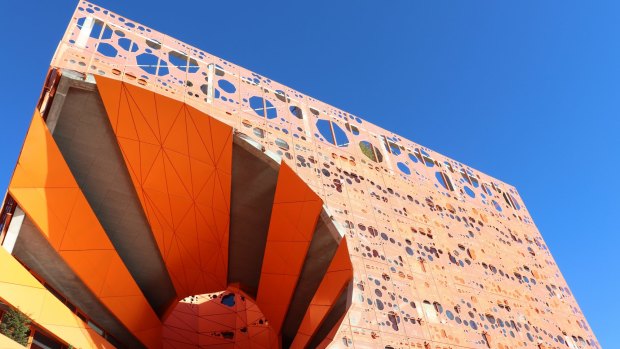
In Lyon, pop your eyes at innovative architecture, including Le Cube Orange.Credit: iStock
When did everything interesting in Europe end? If the standard guidebook is anything to go by, somewhere around the time bishops and counts were building castles and old towns. Perhaps when the Tudors were lopping off heads in England, or the French king was losing his in Paris. Maybe, at the latest, in the very early 20th century, just before all the carriages, crinolines and cuteness were swept away forever.
This is what tourist Europe would have you think, anyway. Only old Europe is attractive and interesting. Its great symbols of oppression – castles and palaces, cathedrals and fortified towns – are applauded and romanticised, and the reigns of its monarchs made into Hollywood movies. Meanwhile modern, democratic, everyman Europe is assumed to be moribund and glum, besieged by multinationals, and beset with inner-city decay and clanking plumbing. Brexit news coverage gives us the impression that some modern Europeans – who don't actually want to be Europeans any more – might even be slightly deranged.
Who tells you that Vilnius has emerged as one of the world's best-managed cities? That a fifth of Stockholm's population works in the hi-tech sector? That Budapest's 7th District and former meatpacking quarter Holesovice in Prague are hopping with the latest, liveliest local life? And hands up if you've heard about the urban redevelopment projects recently started in EuropaCity in Berlin, Nordhavn in Copehagen, Battersea in London and Les Groues in Paris.
There's nothing wrong with admiring and enjoying old Europe; I do it myself. But as a European, I find it frustrating that the tourist narrative finishes with the Russian Revolution or (especially in Italy) with the Renaissance, as if Europeans just gave up and did nothing more after discovering perspective in art, penicillin or the Beatles.
As old towns and standard tourist sights get ever more crowded, it's sometimes a relief to turn to new districts and revamped neighbourhoods as yet unruffled by mass tourism. It's good to be reminded that Europe remains a progressive, happening, interesting continent where we can be impressed and entertained by what's new, rather than long gone.
DESIGN DISTRICT, HELSINKI
WHY WE LOVE IT Finland has always had a flair for minimalist design, and the Design District is crammed with more than 200 stores showcasing furniture, fashion and accessories from up-and-coming and established designers. If you want a peek at Nordic chic, there's no better place.
WHAT TO SEE AND DO Style, functionality and pared-down simplicity are Finnish design's hallmarks. The icons are Artek (artek.fi) for homeware, Iittala (iittala.fi) for glassware and Marimekko (marimekko.com) for bold-coloured floral textiles. Design Forum Finland (designforum.fi) has many brands under one roof.
DON'T MISS In the city centre, the Design Museum (designmuseum.fi) presents Finland's leading 20th-century designers and their international influence on everything from architecture to chairs and vodka bottles.
ESSENTIALS The Design District (designdistrict.fi) has details of boutiques, eateries and opening times. Stay at Sokos Hotel Albert (sokoshotels.fi). See visithelsinki.fi
CITY OF ARTS AND SCIENCES, VALENCIA
WHY WE LOVE IT This entertainment district's dazzlingly white buildings reflected in blue pools, designed by local architect Santiago Calatrava, made Valencia's name. They look variously like an open eye, helmet and whale skeleton, while a bridge resembles a giant harp. Get your camera ready.
WHAT TO SEE AND DO Among much else, L'Hemisfèric contains an IMAX cinema and planetarium, L'Oceanogràfic an aquarium and the Palace of Arts an opera house and performance centre. The very interactive Museum of Science suits children.
DON'T MISS It's worth heading to another uber-modern building, the western suburbs' Valencia Institute of Modern Art (ivam.es), for its extensive collection of abstract and avant-garde art, photography, sculpture and new media.
ESSENTIALS The City of Arts (cac.es) has details of opening times, concerts and exhibitions. Stay at Barcelo Valencia (barcelo.com) for outlooks over the complex. See visitvalencia.com
SALFORD QUAYS, MANCHESTER
WHY WE LOVE IT In the 1980s, what was once Manchester's docks became one of the UK's first great urban renewal projects to revitalise decaying – but architecturally grand – industrial cities. Expect a good buzz and lively cultural scene.
WHAT TO SEE AND DO The Lowry (thelowry.com) incorporates shops, restaurants and the largest theatre outside London, plus a gallery devoted to L.S. Lowry, painter of grim but striking industrial scenes. Take a behind-the-scenes tour at the BBC's northern headquarters (bbc.co.uk/showsandtours) to learn about radio and television production.
DON'T MISS Much more of Manchester has undergone a renaissance, including its grand Victorian-era city centre. A heritage park at Castlefield showcases industrial history, and the Northern Quarter has quirky shopping, gastro-pubs and fashionable bars.
ESSENTIALS See Visit Salford (visitsalford.info) for the latest events. Stay at minimalist, glass-and-steel The Lowry (thelowryhotel.com). See visitmanchester.com
SAVAMALA, BELGRADE
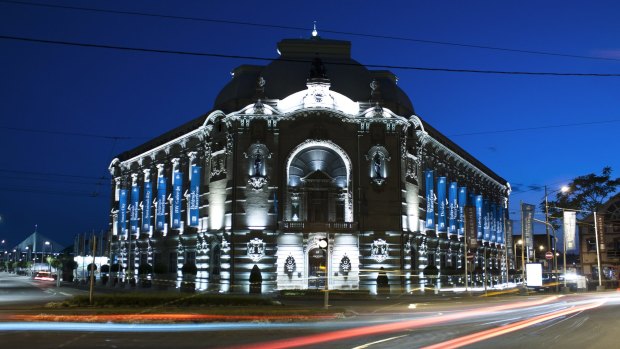
Credit: Alex Linch
WHY WE LOVE IT While Eastern Europe doesn't have the big budgets to transform entire neighbourhoods, local spirit has changed Savamala from down-at-heel district to creative hub and nightlife epicentre. It makes up for its lack of contemporary architecture with a seriously energetic vibe.
WHAT TO SEE AND DO It's all about art galleries, hipster bars, rock cafés, beer gardens and the latest hot restaurants and nightclubs, many lodged in once-derelict Art Nouveau mansions. Beton Hala, at the meeting of the Sava and Danube rivers, houses multiple eateries along a waterside promenade.
DON'T MISS KC Grad (kcgrad.rs), a cultural centre and nightclub inside a warehouse. You never know what concert, film screening or exhibition might take place, and the food it great.
ESSENTIALS For an overdose of hipster-dom and eccentricity, stay at Mama Shelter Belgrade (mamashelter.com), which has a great rooftop bar. See tob.rs
CONFLUENCE DISTRICT, LYON
WHY WE LOVE IT Lyon's Presqu'île (Almost Island between Rhône and Saône rivers) has onion layers of development that particularly flowered in the 19th century. Now its southern tip continues the tradition, its old manufacturing infrastructure replaced with startling buildings by Europe's leading architectural firms.
WHAT TO SEE AND DO Pop your eyes at innovative architecture, including Le Cube Orange and the lurid, hole-punctured EuroNews building. Pôle de Commerces fits 100 shops and restaurants into a light-flooded space. Former sugar factory La Sucrière (lasucriere-lyon.com) hosts art exhibitions, concerts and weekend club nights.
DON'T MISS The extraordinary Musée des Confluences (museedesconfluences.fr), which looks like a pile of crushed scrap metal. The museum explores the nexus between humanities and science and also has excellent temporary exhibitions.
ESSENTIALS Stay at MOB HOTEL Lyon Confluence (mobhotel.com), mid-range but modish. See lyon-france.com
NAVIGLI, MILAN
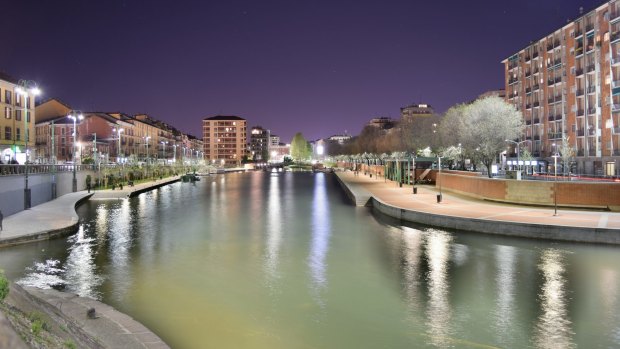
Arnhem, Netherlands - April 19, 2016: Arnhem Centraal railway station with unidentified people. After reconstruction it was reopened 2015. The new design was by UNStudio, that won an architecture price tra29neweuropecover
WHY WE LOVE IT Long an epicentre of fashion, Milan's design ethos has now flowed into art, publishing, food and architecture in a showcase of the dynamism and panache of contemporary northern Italy.
WHAT TO SEE AND DO Navigli's canals once made Milan a significant inland port. Though the look is old, the vibe is contemporary, with former warehouses sheltering design boutiques, artists' studios and wine bars. Street markets and eateries create a vibrant, almost southern-Italian atmosphere. Weekend crowds come for live music.
DON'T MISS Adjacent Zona Tortona, a gritty neighbourhood turned achingly cool design district, anchored by the futuristic Museo delle Culture di Milano (mudec.it) by star architect David Chipperfield.
ESSENTIALS Milan Design Agenda (milandesignagenda.com) has copious cutting-edge information. Stay at the chic NHOW Hotel (nhow-hotels.com), a former factory draped in art. See yesmilano.it
AKER BRYGGE, OSLO
WHY WE LOVE IT This former shipyard site turned sleek harbour-front district of apartments and offices eyeballs Akershus Fortress across the water. It turns Oslo more firmly towards the fiord, and is the place on sunny days for its boardwalks, restaurants terraces and lively atmosphere.
WHAT TO SEE AND DO The Nobel Peace Centre (nobelpeacecenter.org) is the only traditional sight. Kick back and browse the fashion shops and wine bars, pop-up cultural events and exhibitions, and admire old-meets-new architecture.
DON'T MISS Aker Brygge's redevelopment went so well it was extended into Tjuvholmen, where you'll find Norway's top museum, the Renzo Piano-designed Astrup Fearnley Museum of Modern Art (afmuseet.no), surrounded by a sculpture park and popular urban beach.
ESSENTIALS Stay at five-star boutique hotel The Thief (thethief.com), which has designer furniture, artworks and Nordic cuisine. See visitoslo.com
HAFENCITY, HAMBURG
WHY WE LOVE IT Europe's largest urban development scheme began in 2000 and will be completed in 2025. The ambitious 13-billion-euro project has transformed a decaying district into a sleek assembly of offices, apartments and repurposed warehouses. This is impressive, up-to-the-minute modern Germany.
WHAT TO SEE AND DO Top architects have contributed buildings, including the already iconic Elbphilharmonie cultural centre. A sculptural riverside promenade by Zara Hadid turns mundane flood barriers into artwork. Join a one-hour boat tour to inspect the working bowels of this port city.
DON'T MISS Adjacent Speicherstadt was the 19th century's cutting-edge waterfront district. It has remarkably ornate redbrick warehouse lining canals, now buzzing with fashion boutiques, teahouses and galleries.
ESSENTIALS HafenCity (hafencity.com) has updates on the latest projects. Stay at the fun 25hours Hotel Hamburg HafenCity (25hours-hotels.com), which has maritime-themed décor. See hamburg-tourism.de
KLEINBASEL, BASEL
WHY WE LOVE IT Energetic, wealthy Basel has low-key, sophisticated charms, outstanding art museums and superb contemporary architecture, especially in Kleinbasel, a Swiss enclave on the German bank of the Rhine.
WHAT TO SEE AND DO Check out the pharmaceutical-company buildings by world-famous Basel architectural firm Herzog & de Meuron. Renzo Piano's Foundation Beyeler (fondationbeyeler.ch) holds outstanding modern art by Pollock, Warhol and Giacometti. Quirky Museum Jean Tinguely (tinguely.ch) showcases the amusing mechanical concoctions of Switzerland's greatest 20th-century sculptor.
DON'T MISS Just across the German border, the campus of Swiss furniture-maker Vitra has more startling buildings, including Vitra Design Museum (design-museum.de) by Frank Gehry, a Zaha Hadid fire station, and a Herzog & de Meuron showroom.
ESSENTIALS The tourist office's Architecture in Basel brochure details architectural trails. Stay at Der Teufelhof (teufelhof.com) for funky, artist-designed rooms inside 18th-century townhouses. See basel.com
DOCKLANDS, DUBLIN
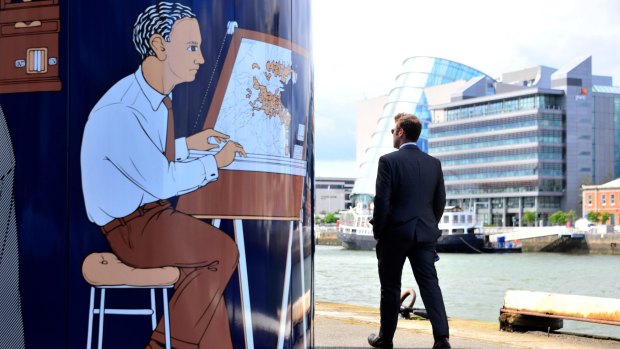
Credit: Alamy
WHY WE LOVE IT Nicknamed Silicon Docks for its many high-tech European headquarters, this formerly derelict River Liffey district now gleams with modern office buildings and events spaces, yet hasn't forgotten its history.
WHAT TO SEE AND DO The landmark convention centre and Grand Canal Theatre (bordgaisenergytheatre.ie) provide the architectural beauty, and arresting public art is dotted everywhere. You can take kayaking, paddle-boarding and boat tours, plus explore maritime history, particularly on board the fascinating Jeanie Johnston famine ship (jeaniejohnston.ie).
DON'T MISS EPIC The Irish Emigration Museum (epicchq.com) traces the story of 10 million Irish immigrants. Sure, it's a dip into history, but its 20 ultra-modern, interactive galleries demonstrate how the Irish have influenced the modern world, including Australia.
ESSENTIALS Dublin Docklands (dublindocklands.ie) has all the details. Stay at The Gibson Hotel (thegibsonhotel.ie) in the middle of the action. See visitdublin.com
TEN OF EUROPE'S BEST MODERN BUILDINGS
Had enough of castles and churches? Refresh your eyes on these contemporary architectural feats.
ELBPHILHARMONIE, HAMBURG
This cultural centre looks like a giant, jagged-topped iceberg, or perhaps a hoisted sail. Its web of steel and glass sits atop 1960s warehouse brickwork. Many of its windows are curved, providing distorted city views. See elbphilharmonie.de
NIARCHOS FOUNDATION CULTURAL CENTRE, ATHENS
The national library and opera occupy this complex designed by Renzo Piano, which erupts out of a hill and has plant-covered roofs. A canopy above the opera house appears to float like a cloud. See snfcc.org
BLACK DIAMOND, COPENHAGEN
The irregular angles of the minimalist, polished granite National Library give it a distorted appearance. The building splits in two to capture light, while glazing overlooks the harbour. Head inside to see delightfully wavy balconies. See kb.dk
HARPA CONCERT HALL, REYKJAVIK
This concert and conference centre is composed of geometric panels of different coloured glass, held together on a steel framework. Its sculptural block shape echoes Iceland's basalt landscapes, and reflect clouds and harbour water. See harpa.is
URBIS, MANCHESTER
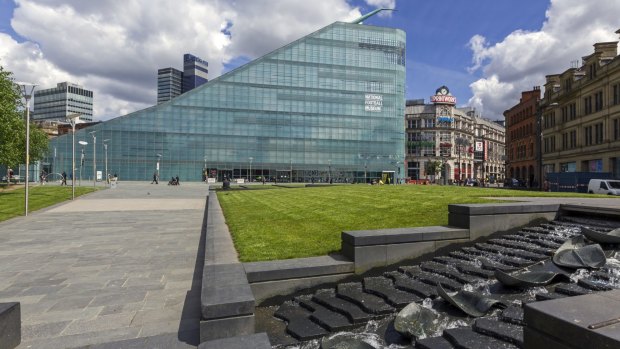
This six-storey, sloping building looks like a giant blue slide and houses the National Football Museum. Its interior is designed for visitors to begin on the top floor and progress downwards on cascading mezzanine levels. See nationalfootballmuseum.com
HOTEL MARQUEZ DE RISCAL, ÁLAVA
This hotel and cellar door in Spain's Rioja wine region is another visual spectacle, in purple and silver titanium, from Frank Gehry, most famous for Bilbao's Guggenheim Museum, which it greatly resembles. See marquesderiscal.com
ARNHEM CENTRAAL, NETHERLANDS
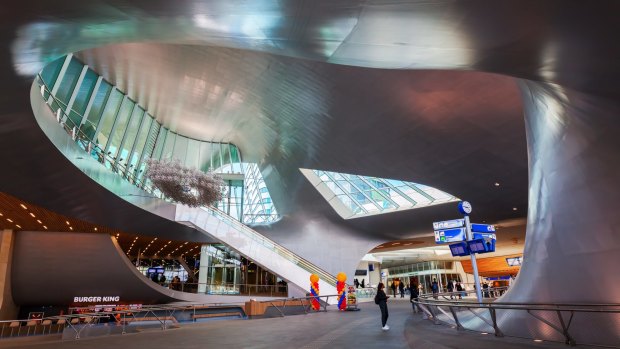
Credit: Chris Mueller
The twisted steel columns and geometric roof angles of this train station's transfer hall are astonishing and beautiful, and inspired by boat-building techniques. The transition between interior and exterior seems blurred, and light is omnipresent. See visitarnhem.com
SONDICA AIRPORT, BILBAO
The main terminal, designed by Santiago Calatrava, demonstrates airports can be lovely. From the air, it resembles a giant dove in flight. From inside, ribbed concrete raises your eyes upwards. Marble gleams and sunlight is abundant. See aena.es
SCANDIC VICTORIA TOWER, STOCKHOLM
This is Stockholm's tallest building, with a mesmerising façade of mismatched, seemingly randomly distributed mirrors that resist pattern and reflect the sky. It's topped by an improbable cuboid, cantilevered over the tower below. See scandichotels.com
GREAT COURT, LONDON
The Norman Foster-designed hub of the British Museum creates Europe's largest covered public square, topped by a spectacular roof of irregular glass panels. Sleek, clever, almost classical architecture is reinvented for the modern age. Brilliant. See britishmuseum.org
MIX AND MATCH
The ancient and modern combine in these charming and lively cities.
GRAZ, AUSTRIA
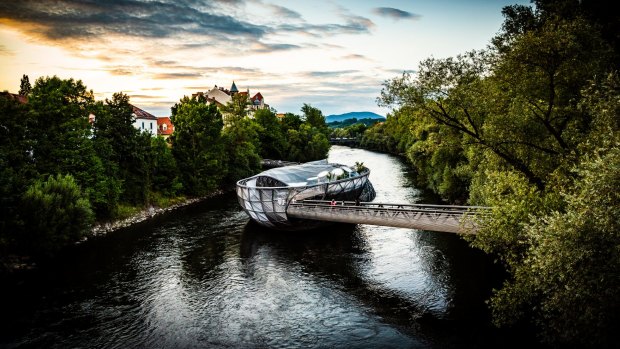
A youthful population, bohemian energy and laidback vibe make this Austria's least staid city. Medieval old-town architecture contrasts with a curved-shell bridge and the art museum's blue fluorescent blob, nicknamed the Friendly Alien. Mariahilfestrasse district has interesting design boutiques. See graztourismus.at
MARSEILLE, FRANCE
One of Europe's oldest, most worn-out cities transformed itself as 2013 European Capital of Culture. Its 2600-year-old Vieux Port harbour is scrubbed, rejuvenated and crowned with the terrific Museum of Mediterranean Civilizations. Up-and-coming La Joliette is packed with restaurants and bars. See marseille-tourisme.com
SPLIT, CROATIA
In 305 Emperor Diocletian knocked up a city-sized retirement palace. It's now the town centre, lively with gelato shops, eateries and boutiques amid Roman pillars. Where else can you enjoy a cocktail in a palace ruin? On the waterfront, graceful contemporary promenades buzz with locals. See visitsplit.com
LEUVEN, BELGIUM
Leuven has all of Europe's old-town hallmarks, from Gothic churches to a medieval university and fabulous town hall. Yet it's also Belgium's beer capital. Bars line cobbled squares, filled with thousands of students. The vibe is lively and progressive, and the nightlife jumping. See visitflanders.com
PORTO, PORTUGAL
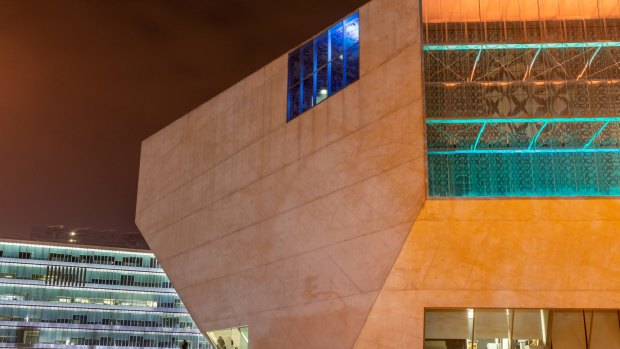
The Romans founded Porto, Americas plunder provided early wealth, and now new energy ripples through the Douro Valley. The waterfront is buzzing. The extraordinary glass-and-steel Casa da Música concert hall clashes with terracotta roofs. Restaurants, cellar doors and boutique hotels provide abundant contemporary chic. See visitportugal.com
POSITIVELY ANCIENT
If you must have the old, here are some of Europe's most ancient sites.
CAVE ART

Credit: Alamy
Europe's oldest cave paintings at Chauvet in France (grottechauvet2ardeche.com) are 30,000 years old. Also in France are the famous Lascaux Caves (lascaux.fr), which recently opened high-tech displays. Spain's Altamire Cave (culturaydeporte.gob.es) has art a mere 14,000 years old, though its bison and horses are startlingly fresh looking.
MEGALITHS
The Cairn of Barnenez in France (barnenez.fr) is the world's oldest enclosed structure with an entrance door, but Malta offers the full megalith experience. The temples at Tarxien, Hagar Qim and Mnajdra (heritagemalta.org) are monumental, sophisticated and an archaeological mystery. They were built between 3600 and 2500 BC.
STONE CIRCLES
Britain, Ireland and Brittany are littered with a thousand stone circles dating to the Late Neolithic, but you'll find examples from Scandinavia to Spain. Carnac in Brittany (carnactourism.co.uk) is the biggest collection, Avebury in Wiltshire (nationaltrust.org.uk) the biggest circle, Stonehenge (english-heritage.org.uk) the most famous yet least atmospheric.
CASTLES
Castles are new by European standards, though preceded by Iron Age forts and other structures. The oldest is likely ninth-century Château de Doué-la-Fontaine in France (ot-saumur.fr), now a rather uninteresting stub. Reichsburg (reichsburg-cochem.de) on Germany's Moselle River and Segovia's Alcázar (segoviaturismo.es) in Spain are spectacular early castles.
CITIES
Greece claims a dozen titles with ancient cities such as Argos, Athens, Chania and Thebes. But don't forget Lisbon in Portugal (visitlisboa.com) and Cadiz in Spain (cadizturismo.com), far older than Rome. Plovdiv in Bulgaria (visitplovdiv.com) has been inhabited for eight millennia and was 2019 European Capital of Culture.
Sign up for the Traveller Deals newsletter
Get exclusive travel deals delivered straight to your inbox. Sign up now.